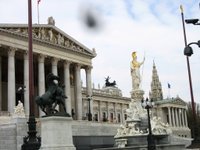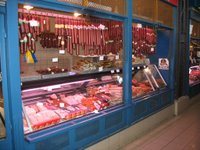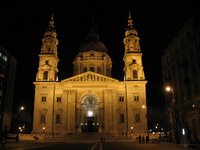 Here are some more images from my time in Budapest and Vienna. First we can see three of the more prominent landmarks in Vienna: On the left, the Austrian Parliament building, on the right in the distance is the Vienna City Hall, in all of it's gothic glory, and in the foreground is Athena, goddess of wisdom..."may she grant some to the Austrian legislative leaders" is how it must go.
Here are some more images from my time in Budapest and Vienna. First we can see three of the more prominent landmarks in Vienna: On the left, the Austrian Parliament building, on the right in the distance is the Vienna City Hall, in all of it's gothic glory, and in the foreground is Athena, goddess of wisdom..."may she grant some to the Austrian legislative leaders" is how it must go.After leaving the downtown Vienna area I ventured into the near northern countryside to the
 community of Nusberg, where they specialize in wine. At these so called Heurigens (wine gardens) you can eat traditional Austrian foods (pork knuckles, jellied pigs brains...I stayed away from these and focused more on the traditional roasted pork and some sort of a cheese-spinach mixture in a flaky crust) and drink great locally made wine. In the area, there a many little winding streets and walking paths. So, to build an appetite, I started walking up one of them into the hills. Along the way I found tiny, beautiful homes with equally tiny, beautiful gardens. Such a peaceful little neighborhood...if this neighborhood had cheeks, I would have squeezed them.
community of Nusberg, where they specialize in wine. At these so called Heurigens (wine gardens) you can eat traditional Austrian foods (pork knuckles, jellied pigs brains...I stayed away from these and focused more on the traditional roasted pork and some sort of a cheese-spinach mixture in a flaky crust) and drink great locally made wine. In the area, there a many little winding streets and walking paths. So, to build an appetite, I started walking up one of them into the hills. Along the way I found tiny, beautiful homes with equally tiny, beautiful gardens. Such a peaceful little neighborhood...if this neighborhood had cheeks, I would have squeezed them.Finally, this is one of those things that I just had to get a picture of. Just a block off Vaci Utca in
 Budapest is this McDonald's. Why so important? I have read that this was the first McDonald's built behind the Iron Curtain (1988). However, another source says the first one was in nearby Gyor, Hungary. So, I'll have to leave that question hanging out there, and in the meantime, enjoy this one in downtown Budapest (By the way, it costs 60 ft - or about 28 cents - for ketchup when you buy French fries at a McDonald's in Hungary. The guy working there even said to me in a very broken English, "How do you say, there's no such thing as free lunch?" I sneered and walked away.)
Budapest is this McDonald's. Why so important? I have read that this was the first McDonald's built behind the Iron Curtain (1988). However, another source says the first one was in nearby Gyor, Hungary. So, I'll have to leave that question hanging out there, and in the meantime, enjoy this one in downtown Budapest (By the way, it costs 60 ft - or about 28 cents - for ketchup when you buy French fries at a McDonald's in Hungary. The guy working there even said to me in a very broken English, "How do you say, there's no such thing as free lunch?" I sneered and walked away.)














